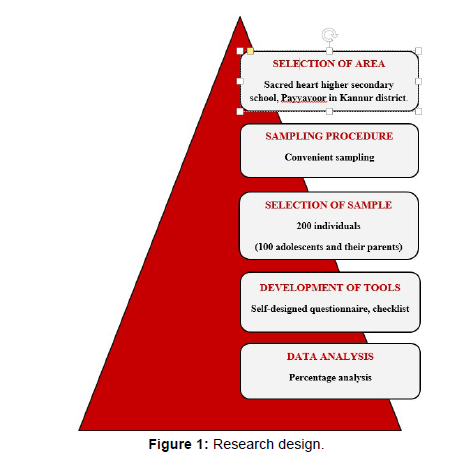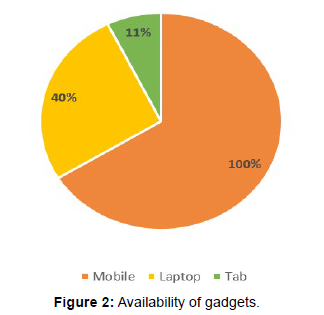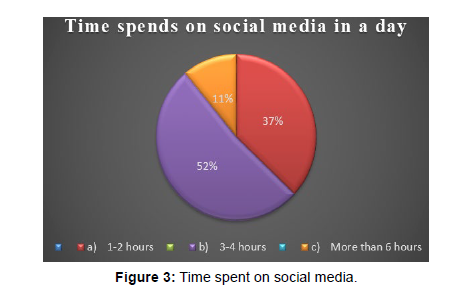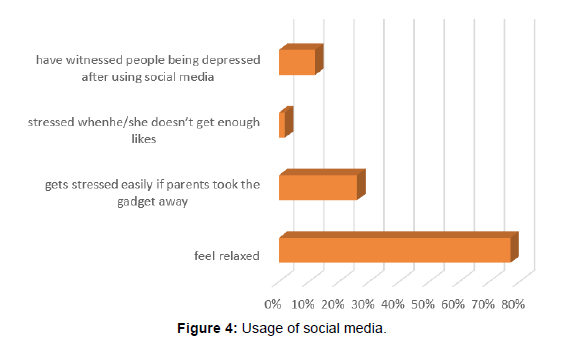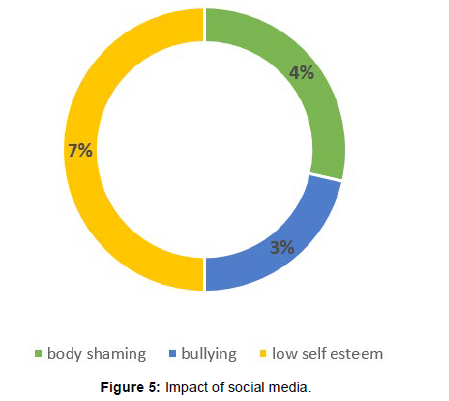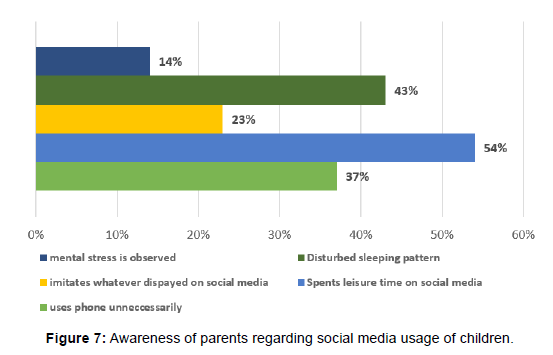Assessment of Social Media Use and Depressive Behavior of Adolescents (14-18 Years) and Awareness of Parents Regarding Social Media Addiction among Adolescents
Received: 15-May-2023 / Manuscript No. jcalb-23-98774 / Editor assigned: 16-May-2023 / PreQC No. jcalb-23-98774(PQ) / Reviewed: 29-May-2023 / QC No. jcalb-23-98774 / Revised: 05-Jun-2023 / Manuscript No. jcalb-23-98774(R) / Accepted Date: 12-Jun-2023 / Published Date: 12-Jun-2023 DOI: 10.4172/2375-4494.1000521 QI No. / jcalb-23-98774
Abstract
The present study “assessment of social media use and depressive behaviour of adolescents (14-18 years) and awareness of parents regarding social media addiction among adolescents” aims to understand the impact of social media among adolescents (14-18 years) and get to know whether the parents are aware of the mental health issues among adolescence due to social media. An awareness program was conducted for parents and teenagers with the help of a resource person on “The impact of social media on adolescents”. The total sample consisted of 200 individuals which included 100 adolescents between the age group of 14-18 years and their parents. A self-designed questionnaire for adolescents and their parents was developed to evaluate their knowledge of the impacts related to the usage of social media. The data gained was analyzed via percentage analysis.
Keywords
Adolescents; Parents; Screen Addiction; Social Media
Introduction
Adolescence is the most vulnerable period of human development and most of the individuals are negatively influenced by environmental factors during adolescence. Many addictive behaviours came to occur during this period including social media addiction, drug addiction etc., and it will eventually affect their future development. Of this, social media plays an important role in the development of adolescents. Most children rely on social media for everything, the risk of addiction is extremely high [1, 2].
The present study has a great gravity in today’s context of children’s life. In the present scenario the role of social media in day-to-day life is inevitable and also the chances of mental health problems like depressive behaviours are significantly high. “Anything good will act as a poison if it is consumed over”, this thought is perfect in the case of social media use among adolescence. Today children are more prone to many threats on internet including bullying, addiction, sexting, violent content. This will affect their academic, social, mental and physical health also [3].
Moreover, due to the rapid change in technology, parents have lesser knowledge regarding social media use. They don’t even know how to use the phone properly, what are all applications that are available, how adolescents handle the phone, whether they are using sites which are not permitted to use. These all prevent parents and children for the effective use of technology [4, 5].
Aim
The present study aims to understand the impact of social media among adolescents (14-18 years) and get to know whether the parents are aware about the mental health issues among adolescence due to social media.
Objectives
• To assess the level of usage of social media among adolescents.
• To assess the impact of the usage of social media among
• To give awareness about social media use and behavioural problems to adolescents and their parents.
• To study whether social media leads to depressive behaviour among adolescents.
• To conduct an awareness session through a resource person.
Methodologys
The methodology of the study entitled “social media use and depressive behaviour of adolescence” is exemplified (Figure 1).
Results and Discussion
The results obtained after analysis of data and its discussions are described in this segment.
Figure 2 points out that cent percent of the students have mobile phones, 40 percent of the respondents have laptops and 11 percent of them have a tablet. From Figure 3 we can notice that around 11 percent spent more than 6 hours per day on social media.
It is clear from the Figure 4 that 26 percent of students were feeling stressed when their parents took away their phone forcefully and 74 percent of the respondent’s claims that they did not feel stressed during such situations. Minority (2%) of respondents felt stressed when they don’t get the expected response for a post uploaded in social media, 13 percent of the respondents felt the same sometimes and majority (85%) of students weren’t stressed about it.
From Figure 5, it was astonishing to note that about 3 percent of the respondents experienced bullying via social media sites, 4 percent of the students felt embarrassed about their body image and about 7 percent of the respondents felt useless due to social media usage. From Figure 6 and Figure 7, it’s evident that around 16 percent of the respondents accept that they are addicted to social media and five percent of them believes that it is ok to get addicted. About 12 percent of the teenagers pinpoints that it affects their sleep and 17 percent of them propounds that social media addiction can lead to poor family relationship and interaction [6].
It was interesting to note that 37% of the parents complained of the child using phone unnecessarily and more than half of them pointed out that their children spent their leisure time online. Around 23% of the respondents stated that the children imitates whatever it is shown on social media, 43% of them explained that social media addiction leads to disturbed sleeping pattern and 14 percent of them noticed stress among the children due to addiction [7].
Evaluation of Webinar
They demonstrated below depicts the evaluation of the awareness class taken by the resource person on “impact of social media among adolescents”.
From them it was interesting to note that 62 percent of the respondents understood the concept and was satisfied with the information they have gained on social media usage. Cent percent of the respondents accepted that the webinar provided adequate information regarding all the essential concepts of social media. Around 94 percent of the participants pointed out that they learned the fact related to mental health effects of social media among teenagers and how to rectify such situations. In total, 72% of the participants rated very good for the overall efficacy of the program conducted [8, 9].
Conclusion
The present study discusses “social media use and depressive behaviour of adolescents and assessing the awareness of parents regarding social media addiction among adolescents”. This study enables parents and adolescents to understand social media addiction through the questionnaire provided. It also analyses their awareness regarding the depressive behaviours caused by social media use.
The study concluded that more than half of the participants were aware of social media addiction and mental health issues due to social networking sites. Majority of the parents have an opinion that their child is being addicted to social media and it has been reflected in their behaviour especially in academics. The awareness session was beneficial for both parents and adolescents as it provided adequate information regarding the selected topic [10].
Acknowledgement
None
Conflict of Interest
None
References
- Miech RA, Johnston LD, O'Malley PM, Bachman JG, Schulenberg JE, et al. (2022) Monitoring the Future National Survey Results on Drug Use, 1975-2021: Volume 1, Secondary School Students. Institute for Social Research. 2022 Jun.
- Miech RA, Johnston LD, Patrick ME, O’Malley PM, Bachman JG, et al. (2023) Monitoring the future national survey results on drug use, 1975–2022: Secondary school students. Ann Arbor 597: 1.
- Andrade FH (2014) Co-occurrences between adolescent substance use and academic performance: school context influences a multilevel-longitudinal perspective. J Adolesc 37: 953-963.
- Hicks BM, Iacono WG, McGue M (2010) Consequences of an adolescent onset and persistent course of alcohol dependence in men: Adolescent risk factors and adult outcomes. Alcohol Clin Exp Res 34: 819-833.
- Jones TM, Hill KG, Epstein M, Lee JO, Hawkins JD, et al. (2016) Understanding the interplay of individual and social–developmental factors in the progression of substance use and mental health from childhood to adulthood. Dev Psychopathol 28: 721-741.
- Gray KM, Squeglia LM (2018) Research Review: What have we learned about adolescent substance use?. J Child Psychol Psychiatry 59: 618-627.
- Paruthi S, Brooks LJ, D' Ambrosio C, Hall WA, Kotagal S, et al. (2016) Recommended amount of sleep for pediatric populations: a consensus statement of the American Academy of Sleep Medicine. J Clin Sleep Med 12: 785-786.
- Tarokh L, Saletin JM, Carskadon MA (2016) Sleep in adolescence: Physiology, cognition and mental health. Neurosci Biobehav Rev 70: 182-188.
- Wheaton AG, Claussen AH (2021) Short sleep duration among infants, children, and adolescents aged 4 months-17 years-United States, 2016-2018. Morb and Mor Week Rep 70: 1315.
- Kansagra S (2020) Sleep disorders in adolescents. Pediatr 145: 204-209.
Indexed at, Google Scholar, Crossref
Indexed at, Google Scholar, Crossref
Indexed at, Google Scholar, Crossref
Indexed at, Google Scholar, Crossref
Indexed at, Google Scholar, Crossref
Indexed at, Google Scholar, Crossref
Citation: Elizabath J, Dhanya N (2023) Assessment of Social Media Use andDepressive Behavior of Adolescents (14-18 Years) and Awareness of ParentsRegarding Social Media Addiction among Adolescents. J Child Adolesc Behav 11:521. DOI: 10.4172/2375-4494.1000521
Copyright: © 2023 Elizabath J. This is an open-access article distributed underthe terms of the Creative v Attribution License, which permits unrestricted use,distribution, and reproduction in any medium, provided the original author andsource are credited.
Share This Article
Open Access Journals
Article Tools
Article Usage
- Total views: 1138
- [From(publication date): 0-2023 - Apr 05, 2025]
- Breakdown by view type
- HTML page views: 916
- PDF downloads: 222

